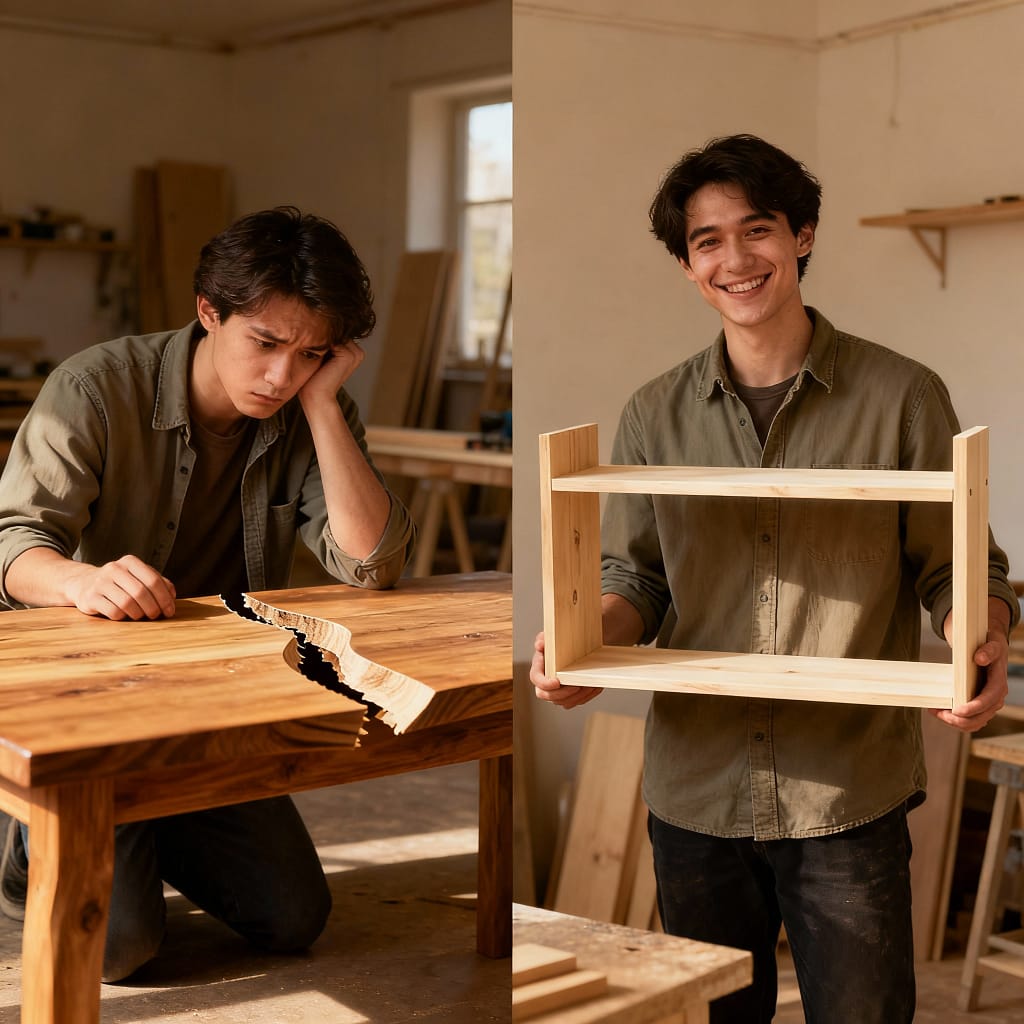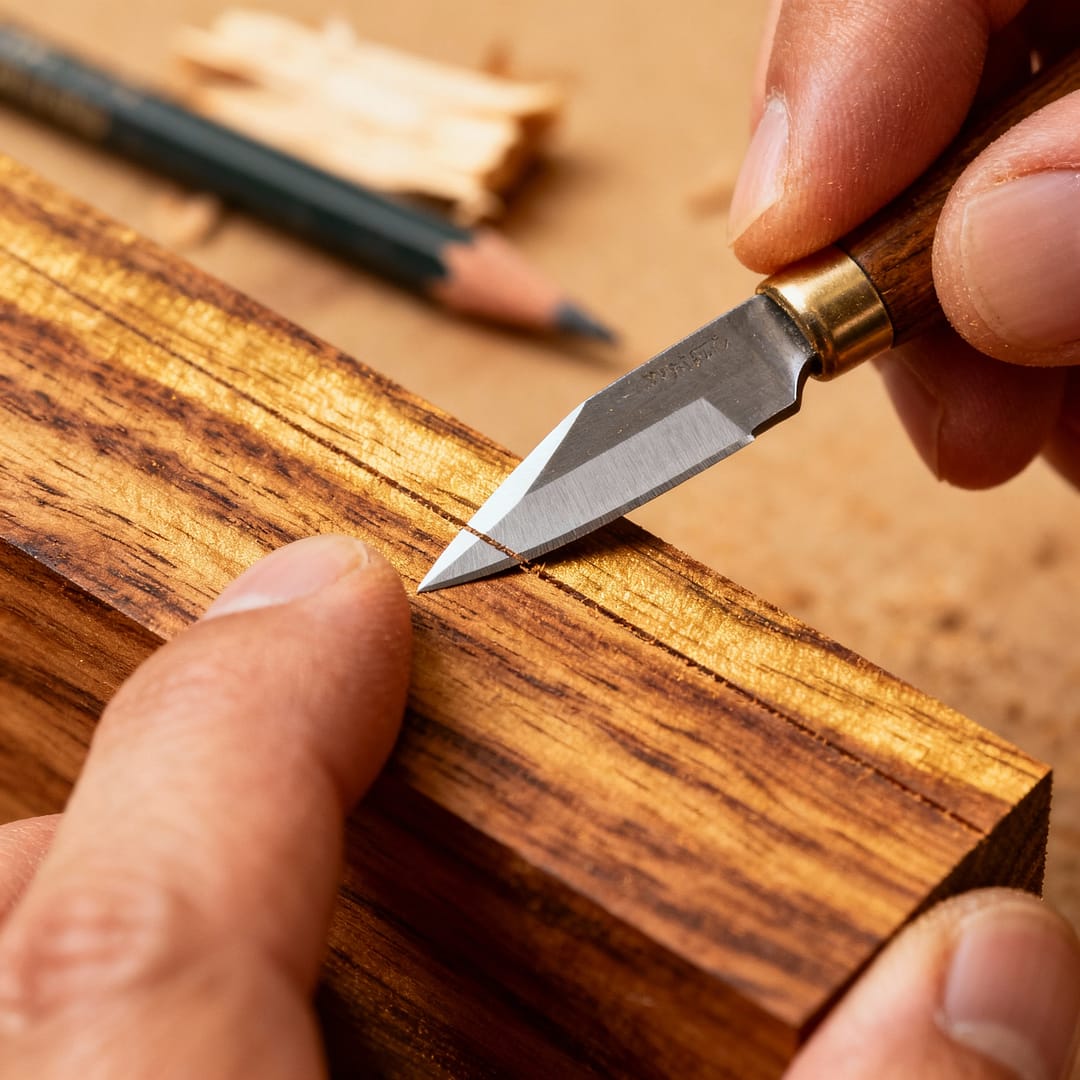10 Woodworking Mistakes Beginners Make (And How to Avoid Each One)

I’ve ruined more projects than I care to admit.
Twenty-plus years in the shop, and I can still remember staring at a pile of expensive walnut that looked like it went through a blender instead of my careful hands.
If you’re reading this with sawdust in your hair and frustration in your heart, trust me — you’re not alone.
These woodworking mistakes beginners make happen to everyone. Even now, I occasionally catch myself making the same bonehead moves that turned my early projects into expensive firewood.
But here’s the thing:
Once you know what to watch for, avoiding these fails becomes second nature.
Let me walk you through the 10 biggest project killers I see beginners struggle with — and the simple fixes that’ll save you time, money, and sanity.
Mistake #1: Ignoring Wood Movement (The Silent Project Destroyer)
What happens: Your beautiful table cracks down the middle in humid summer.
Why: Wood expands and contracts across the grain — and if you glue it rigidly, it will split.
🧑🔧 Daniel’s Story: I built a kitchen table for my sister in dry February. By July, the top had split like Moses parting the Red Sea. I was mortified.
The Fix:
- Use floating panels (don’t glue solid wood directly to aprons)
- For tabletops, use figure-8 fasteners or breadboard ends
- Always ask: “What happens when this wood swells?”
Mistake #2: Poor Measuring and Marking (Measure Twice, Swear Once)
What happens: Every shelf is 1/8” too long. Nothing fits.
Why: Using dull pencils, skipping kerf width, or switching tape measures mid-project.
The Fix:
- Mark with a sharp knife — not a pencil (0.5mm vs 2mm line)
- Account for kerf (blade removes 1/8” of wood — plan for it)
- Write measurements on the wood after marking
Pro Tip: If you’re not sure, cut a test piece first. It’s faster than fixing a mistake.
Mistake #3: Rushing the Sanding Process (The Scratch Amplifier)
What happens: Stain highlights every deep scratch like a neon sign.
Why: Jumping from 80 grit straight to 220.
The Fix:
- Don’t skip grits: 120 → 150 → 180 → 220
- Sand with the grain on your final pass
- Check with raking light — hold a flashlight sideways to reveal hidden scratches
Reality Check: If you’re spending less than 30% of your time on sanding and finishing, you’re rushing it.
Mistake #4: Wrong Glue Application (The Squeeze-Out Nightmare)
What happens: Glue lines reject stain. Joints fail.
Why: Drowning joints in glue or not cleaning squeeze-out.
The Fix:
- Use just enough glue for a thin, continuous film
- Clean squeeze-out immediately with a damp cloth
- For stained projects, consider hide glue (takes stain better)
Rule: If you’re not getting a little squeeze-out, you didn’t use enough. If you’re getting a river, you used too much.
Mistake #5: Ignoring Grain Direction (The Tear-Out Generator)
What happens: Routing leaves a chewed-up edge that looks like a beaver attacked it.
Why: Working against the grain.
The Fix:
- Read the grain before every cut
- For routing/planing: grain should angle down and away from your cut direction
- When gluing panels, alternate end grain to prevent cupping

Mistake #6: Inadequate Clamping (The Gap Creator)
What happens: Joints have gaps. Tables bow in the middle.
Why: Uneven pressure or too few clamps.
The Fix:
- Use enough clamps to distribute pressure evenly
- Alternate clamps above and below to prevent bowing
- Tighten gradually and evenly — like a firm handshake, not a death grip
Mistake #7: Skipping Test Fits (The “Prayer and Hope” Method)
What happens: Glue is setting while you fumble with parts. Nothing fits.
Why: Assuming your cuts are perfect without checking.
The Fix:
- Always do a dry fit before glue-up
- Rehearse your clamping sequence
- Have all tools ready — no last-minute scrambling
🧑🔧 Daniel’s Story: I once skipped a test fit on a jewelry box. Assembly day was a disaster — gaps everywhere. Now, I never glue without a dry run.
Mistake #8: Using Dull Blades and Bits
What happens: Burning, tear-out, motor strain.
Why: Thinking “it’s still cutting” means it’s sharp enough.
The Fix:
- Replace or sharpen when you see burning or fuzzy cuts
- Clean pitch buildup with oven cleaner and a brass brush
- Rotate blades — don’t wait for total failure
Mistake #9: Poor Dust Management
What happens: Clogged pores, poor finish, health risks.
Why: Treating dust as “just cleanup” instead of a core part of the process.
The Fix:
- Connect dust collection to every tool
- Wear a respirator for sanding and routing
- Clean your shop weekly — sawdust is flammable and toxic
Mistake #10: Not Tuning Your Table Saw
What happens: Crooked cuts, binding, kickback.
Why: Assuming “it came from the factory aligned.”
This is the #1 foundational mistake — because every project starts with a cut.
If your saw isn’t tuned, nothing else matters.
That’s why I created the FREE “Dead-Square Every Time” Table Saw Tune-Up Checklist.
It’s a 15-minute guide to calibrating your saw for perfect 90° cuts — no dial indicator needed.
It’s the first step to avoiding all 10 of these mistakes — because precision starts with your core tool.
You’ve Got This
These woodworking mistakes beginners make aren’t signs you should quit.
They’re tuition payments in the University of Hard Knocks.
Every master woodworker has a graveyard of failed projects.
The difference?
They learned to fix them — and kept building.
Pick one mistake from this list that bit you last time.
Focus on fixing just that one.
Your next project will be better.
And your project after that? Even better.
Go build something great — and don’t be afraid to make a few interesting mistakes along the way.
— Daniel
HMZ Woodz
